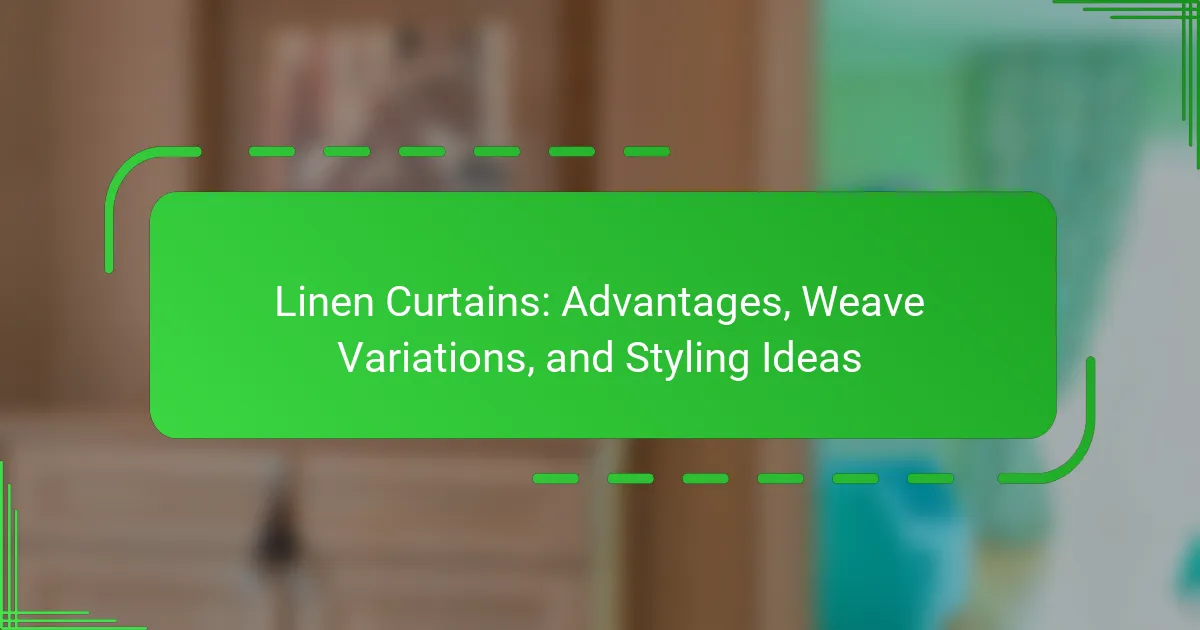Linen curtains are window treatments crafted from natural linen fabric, which is derived from the flax plant. Known for their lightweight and breathable qualities, these curtains offer an elegant aesthetic while effectively filtering light and maintaining privacy. The article explores various weave variations of linen curtains, including plain weave, twill weave, and herringbone weave, each contributing unique textures and styles. Additionally, it provides popular styling ideas that enhance the versatility and visual appeal of linen curtains, such as layering with sheer fabrics, using complementary curtain rods, and incorporating natural elements for a cohesive decor.

What are Linen Curtains?
Linen curtains are window treatments made from linen fabric. Linen is a natural fiber derived from the flax plant. These curtains are known for their lightweight and breathable qualities. They provide a soft, elegant look to interior spaces. Linen curtains can filter light while still maintaining privacy. They are available in various colors and patterns. The fabric’s texture adds depth and warmth to a room. Linen is also durable, making these curtains a long-lasting choice for home decor.
How are Linen Curtains made?
Linen curtains are made from fibers derived from the flax plant. The process begins with harvesting flax stalks, which are then retted to separate the fibers. After retting, the fibers are dried and processed to remove impurities. Next, the clean fibers are spun into yarn. This yarn is then woven into fabric using various weaving techniques. The woven fabric is cut to size and sewn into curtains. Finally, finishing touches such as hems and eyelets are added for functionality. This traditional method has been used for centuries, ensuring durability and a natural aesthetic.
What materials are used in the production of Linen Curtains?
Linen curtains are primarily made from flax fibers. Flax is a natural plant-based material known for its durability. The production process involves harvesting, retting, and spinning flax into threads. These threads are then woven into fabric to create linen. Linen is valued for its breathability and moisture-wicking properties. Additionally, some linen curtains may incorporate cotton or synthetic fibers for enhanced texture or durability. Cotton blends can provide a softer feel while maintaining the benefits of linen. The combination of these materials contributes to the overall quality and aesthetic of linen curtains.
What is the typical manufacturing process for Linen Curtains?
The typical manufacturing process for linen curtains involves several key steps. First, high-quality flax fibers are harvested from the flax plant. Next, these fibers undergo a process called retting, which separates the fibers from the plant’s woody parts. After retting, the fibers are dried and then spun into yarn. This yarn is woven into fabric using looms, creating the linen material.
Once the fabric is produced, it is cut to the desired size for curtains. The edges are then hemmed to prevent fraying. Finally, the curtains are finished with any additional features, such as lining or decorative elements, before being packaged for sale. This process ensures that linen curtains are durable and aesthetically pleasing.
What are the advantages of using Linen Curtains?
Linen curtains offer numerous advantages for home decor. They are highly breathable, allowing air circulation while providing privacy. Linen is also a natural insulator, helping to regulate indoor temperatures. Additionally, linen curtains are durable and can withstand wear and tear over time. They have a timeless aesthetic that complements various interior styles. The fabric also drapes beautifully, enhancing the overall look of a room. Furthermore, linen is eco-friendly, as it is made from flax, a sustainable plant. These properties make linen curtains a practical and stylish choice for any space.
How do Linen Curtains contribute to energy efficiency?
Linen curtains contribute to energy efficiency by providing natural insulation. They help regulate indoor temperatures by blocking heat in the summer and retaining warmth in the winter. This insulation effect reduces the need for heating and cooling systems. According to studies, using thermal curtains can lower energy bills by up to 25%. Linen’s breathable fabric allows for air circulation while still offering protection from temperature fluctuations. Additionally, their light-filtering properties help maintain natural light without excessive heat gain. Overall, linen curtains are an effective choice for enhancing energy efficiency in homes.
What are the aesthetic benefits of Linen Curtains?
Linen curtains enhance aesthetics by providing a natural, textured look. They create a soft, airy atmosphere in any room. The fabric’s unique weave allows light to filter gently, adding warmth. Linen’s natural fibers have a subtle sheen, which elevates visual appeal. Additionally, the drape of linen creates elegant lines and movement. Its versatility complements various interior styles, from rustic to modern. Linen curtains also come in a range of colors and patterns, offering customization options. This adaptability allows for seamless integration into diverse decor themes.
How do Linen Curtains impact indoor air quality?
Linen curtains can positively impact indoor air quality. They are made from natural fibers, which are less likely to release harmful chemicals compared to synthetic materials. Linen is breathable, allowing for better air circulation in a room. This can help reduce humidity levels, which in turn minimizes mold growth. Additionally, linen curtains can trap dust and allergens, preventing them from circulating in the air. Studies indicate that natural fibers like linen can improve overall indoor air quality by reducing volatile organic compounds (VOCs). Thus, using linen curtains can contribute to a healthier indoor environment.

What are the different weave variations of Linen Curtains?
The different weave variations of linen curtains include plain weave, twill weave, and herringbone weave. Plain weave is the most basic type, offering a simple, smooth texture. Twill weave creates a diagonal pattern, adding depth and durability. Herringbone weave features a distinctive V-shaped pattern, providing a classic look. Each weave variation affects the fabric’s drape and appearance. These variations allow for diverse styling options in home decor.
What types of weaves are commonly used in Linen Curtains?
Common types of weaves used in linen curtains include plain weave, twill weave, and satin weave. Plain weave is the most basic structure, providing a flat and smooth surface. Twill weave creates a diagonal pattern, enhancing durability and texture. Satin weave results in a lustrous finish, offering a more luxurious appearance. Each weave type contributes to the overall aesthetic and functionality of linen curtains.
How does the weave affect the texture of Linen Curtains?
The weave significantly affects the texture of linen curtains. Different weaving techniques create varying surface characteristics. For instance, a plain weave results in a smooth and uniform texture. Conversely, a twill weave introduces a diagonal pattern, enhancing softness and drape. Additionally, a herringbone weave offers a more complex texture with visual interest. The density of the weave also impacts the fabric’s overall feel. Tighter weaves create a denser, crisper texture while looser weaves yield a softer, more relaxed appearance. These variations influence how light interacts with the fabric, affecting opacity and style. Overall, the weave type plays a crucial role in defining the tactile and aesthetic qualities of linen curtains.
What are the benefits of different weave types in terms of light filtration?
Different weave types in linen curtains impact light filtration significantly. A tighter weave offers better light blockage, providing privacy and reducing glare. This is beneficial in rooms where sunlight control is essential. Conversely, a looser weave allows more natural light to filter through. This creates a softer ambiance and can enhance the overall aesthetic of a space.
For example, sheer linen curtains have an open weave that diffuses light beautifully. They brighten a room while maintaining a degree of privacy. In contrast, heavier, densely woven linen curtains can block UV rays effectively. This protects furniture from fading and helps maintain a cooler indoor temperature.
Thus, the choice of weave type directly influences how much light enters a space and the overall comfort level.
How does the weave variation influence the durability of Linen Curtains?
Weave variation significantly influences the durability of linen curtains. Different weaves create distinct fabric structures. A tighter weave typically enhances durability by reducing fraying and wear. Conversely, a looser weave may increase breathability but decrease longevity. For instance, plain weaves are generally stronger than twill weaves. This is due to the way fibers interlock in a plain weave, providing more stability. Additionally, the quality of linen fibers used also affects durability. Higher quality fibers can withstand wear better, regardless of the weave type. Thus, selecting the appropriate weave is crucial for maximizing the lifespan of linen curtains.
Which weave types are best for high-traffic areas?
Tightly woven fabrics are best for high-traffic areas. These weaves include canvas, twill, and denim. Canvas is durable and withstands wear and tear effectively. Twill offers a diagonal pattern that enhances strength and resilience. Denim is robust and can handle heavy use without significant damage. These weave types provide longevity and maintain appearance despite frequent movement. Their structural integrity is crucial in busy environments.
How do different weaves affect the care and maintenance of Linen Curtains?
Different weaves affect the care and maintenance of linen curtains significantly. Plain weaves are easier to clean and maintain due to their smooth texture. Twill weaves, with their diagonal pattern, may require more careful washing to avoid fraying. Sateen weaves can be more prone to showing stains and may need special treatment. The tighter the weave, the more durable the fabric, which can reduce wear and tear during cleaning. Additionally, looser weaves may require more frequent washing as they can attract dust and dirt. Understanding these differences helps in choosing the right care methods for each type of weave.

What are some popular styling ideas for Linen Curtains?
Popular styling ideas for linen curtains include layering with sheer fabrics. This technique softens the light while adding depth. Another idea is to use curtain rods that complement the room’s decor. Decorative tiebacks can enhance the appearance by holding curtains back elegantly. Additionally, opting for a relaxed, casual drape creates a laid-back ambiance. Using patterned linen can also add visual interest. Finally, pairing linen curtains with natural elements, like wood or plants, creates a harmonious look. These ideas are favored for their versatility and aesthetic appeal.
How can Linen Curtains be styled in various interior designs?
Linen curtains can be styled in various interior designs by utilizing their natural texture and versatility. In a minimalist design, they create a soft, airy feel. For bohemian styles, layered linen curtains add depth and warmth. In traditional settings, linen curtains can be paired with ornate hardware for an elegant touch. In modern designs, sheer linen curtains allow natural light while maintaining privacy. They can also be used in coastal themes to evoke a breezy atmosphere. To enhance a rustic look, linen curtains in earthy tones complement wooden elements. These styling options leverage linen’s breathable quality and aesthetic appeal.
What are the best color combinations for Linen Curtains?
The best color combinations for linen curtains include soft neutrals, pastels, and bold contrasts. Soft white linen pairs well with light gray for a serene look. Beige linen complements earthy tones like olive green. Light blue linen curtains look fresh against crisp white walls. For a bolder choice, deep navy linen can contrast beautifully with bright yellow accents. These combinations enhance the natural texture of linen and create a harmonious atmosphere.
How can Linen Curtains be paired with other window treatments?
Linen curtains can be paired with other window treatments for enhanced style and functionality. Layering linen curtains with sheer curtains softens light and adds depth. This combination allows for privacy while maintaining a light, airy feel. Additionally, pairing linen curtains with blackout shades provides complete light control. This is ideal for bedrooms or media rooms. Using decorative rods or finials can also add visual interest when combining treatments. The natural texture of linen complements various materials like wood or metal. This versatility makes linen curtains suitable for both modern and traditional interiors.
What practical tips should be considered when choosing Linen Curtains?
When choosing linen curtains, consider the fabric’s weight and opacity. Heavier linen provides better light control and insulation. Lighter linen allows more natural light to filter through. Check the weave pattern; tighter weaves offer increased durability. Look for pre-washed options, as they typically have a softer feel. Ensure the color complements your existing décor and enhances the room’s ambiance. Consider the length and width for proper coverage and aesthetic appeal. Finally, review care instructions; some linen curtains may require special cleaning methods.
How do you measure for the perfect fit of Linen Curtains?
To measure for the perfect fit of linen curtains, start by determining the width of your window. Measure the width of the window frame from one side to the other. Next, decide how much fullness you want. A common recommendation is to multiply the window width by 1.5 to 3 times for a fuller look.
Then, measure the height from the top of the window frame to the desired length. This could be to the sill, below the sill, or to the floor. For floor-length curtains, consider adding extra length for a slight puddle effect if desired.
Lastly, account for the curtain rod placement. Measure from where the rod will be installed, usually above the window frame, to the desired length. This ensures the curtains hang correctly and achieve the intended aesthetic.
What maintenance practices keep Linen Curtains looking their best?
Regular maintenance of linen curtains includes washing, ironing, and proper storage. Washing linen curtains should occur every few months. Use a gentle cycle with cold water to preserve fabric quality. Avoid bleach, as it can damage the fibers.
Ironing is essential for maintaining a crisp appearance. Use a medium heat setting and steam to remove wrinkles. Hang curtains immediately after washing to minimize creasing.
Proper storage is crucial when curtains are not in use. Store them in a cool, dry place to prevent mildew. Avoid direct sunlight to prevent fading.
These practices ensure linen curtains remain vibrant and aesthetically pleasing over time.
Linen curtains are window treatments crafted from natural flax fibers, known for their lightweight, breathable qualities and elegant aesthetic. This article covers the manufacturing process, advantages, and energy efficiency benefits of linen curtains, as well as their impact on indoor air quality. Additionally, it explores various weave types, their influence on durability and light filtration, and popular styling ideas for integrating linen curtains into different interior designs. Practical tips for selection, measurement, and maintenance are also provided to ensure optimal use of linen curtains in home decor.
